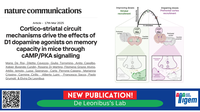Cortico-striatal circuit mechanisms drive the effects of D1 dopamine agonists on memory capacity in mice through cAMP/PKA signalling
Authors: Maria De Risi, Diletta Cavezza, Giulia Torromino, Anita Capalbo, Xabier Bujanda Cundin, Rosaria Di Martino, Filomena Grazia Alvino, Attilio Iemolo, Luisa Speranza, Carla Perrone-Capano, Marianna Crispino, Carmine Cirillo , Alberto Luini , Francesca Sacco, Paolo Grumati & Elvira De Leonibus
Year: 2025
Sources: nature communications
Abstract:
Working memory capacity (WMC), the number of items remembered in a short-time interval, is regulated by fronto-striatal dopamine (DA) and is reduced in schizophrenia. We investigated how excessive and insufficient D1 dopamine receptor stimulation impairs and expands WMC, focusing on the cAMP/PKA pathway in the fronto-striatal circuit. Low doses of the D1 agonist SKF 38393 enhance WMC by activating the striatum (mice remember more objects), while high doses, paradoxically, impair WMC, activating the same pathway in the medial prefrontal cortex (mPFC) but inhibiting it in the striatum. This impairment, arising from mPFC-driven recruitment of inhibitory striatal parvalbumin interneurons, can be prevented by optogenetic inhibition of the mPFC-striatal pathway. Low doses of SKF 38393 also rescue WMC deficits in a schizophrenia mouse model. These results highlight the need for a systems pharmacology approach that considers complex brain interactions and intracellular signalling pathways, rather than isolated drug-receptor interactions, to develop memory-enhancing treatments.
Category: journals

